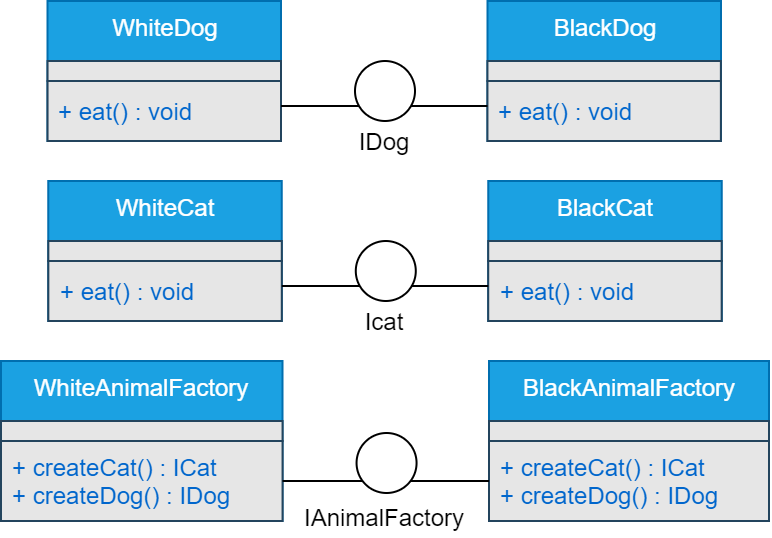本文内容来源于网络收集
作者:冰河
来源:冰河技术公众号
- 本章难度:★★☆☆☆
- 本章重点:用最简短的篇幅介绍抽象工厂模式最核心的知识,理解抽象工厂模式的设计精髓,并能够灵活运用到实际项目中,编写可维护的代码。
一、概述
提供一个创建一系列相关或相互依赖对象的接口,而无需指定它们具体的类。
二、为何使用
工厂模式是我们最常用的模式了,著名的Jive论坛 ,就大量使用了工厂模式,工厂模式在Java程序系统可以说是随处可见。
为什么工厂模式是如此常用?因为工厂模式就相当于创建实例对象的new,我们经常要根据类Class生成实例对象,如A a=new A() 工厂模式也是用来创建实例对象的,所以以后new时就要多个心眼,是否可以考虑实用工厂模式,虽然这样做,可能多做一些工作,但会给你系统带来更大的可扩展性和尽量少的修改量。
三、实用性
- 一个系统要独立于它的产品的创建、组合和表示时。
- 一个系统要由多个产品系列中的一个来配置时。
- 当你要强调一系列相关的产品对象的设计以便进行联合使用时。
- 当你提供一个产品类库,而只想显示它们的接口而不是实现时。
四、参与者
- AbstractFactory 声明一个创建抽象产品对象的操作接口。
- ConcreteFactory 实现创建具体产品对象的操作。
- AbstractProduct 为一类产品对象声明一个接口。
- ConcreteProduct 定义一个将被相应的具体工厂创建的产品对象。 实现AbstractProduct接口。
- Client 仅使用由AbstractFactory和AbstractProduct类声明的接口
五、类图
六、示例
定义抽象工程类IAnimalFactory
1
2
3
4
5
6
7
8
9
10
11
12
|
public interface IAnimalFactory {
/**
* 定义创建Icat接口实例的方法
* @return
*/
ICat createCat();
/**
* 定义创建IDog接口实例的方法
* @return
*/
IDog createDog();
}
|
创建抽象工厂类的两个实现类,WhiteAnimalFactory和BlackAnimalFactory
1
2
3
4
5
6
7
8
9
10
|
public class WhiteAnimalFactory implements IAnimalFactory {
public ICat createCat() {
return new WhiteCat();
}
public IDog createDog() {
return new WhiteDog();
}
}
|
1
2
3
4
5
6
7
8
9
10
11
|
public class BlackAnimalFactory implements IAnimalFactory {
@Override
public ICat createCat() {
return new BlackCat();
}
public IDog createDog() {
return new BlackDog();
}
}
|
定义抽象工厂中要生产的抽象产品接口ICat和IDog
1
2
3
4
5
6
|
public interface ICat {
/**
* 定义方法
*/
void eat();
}
|
1
2
3
4
5
6
|
public interface IDog {
/**
* 定义方法
*/
void eat();
}
|
创建产品的实现类BlackCat、BlackDog、WhiteCat、WhiteDog
1
2
3
4
5
6
|
public class BlackCat implements ICat {
@Override
public void eat() {
System.out.println("The black cat is eating!");
}
}
|
1
2
3
4
5
6
|
public class BlackDog implements IDog {
@Override
public void eat() {
System.out.println("The black dog is eating");
}
}
|
1
2
3
4
5
6
|
public class WhiteCat implements ICat {
@Override
public void eat() {
System.out.println("The white cat is eating!");
}
}
|
1
2
3
4
5
6
7
|
public class WhiteDog implements IDog {
@Override
public void eat() {
System.out.println("The white dog is eating!");
}
}
|
定义一个测试类Test
1
2
3
4
5
6
7
8
9
10
11
12
13
14
15
|
public class Test {
public static void main(String[] args) {
IAnimalFactory blackAnimalFactory = new BlackAnimalFactory();
ICat blackCat = blackAnimalFactory.createCat();
blackCat.eat();
IDog blackDog = blackAnimalFactory.createDog();
blackDog.eat();
IAnimalFactory whiteAnimalFactory = new WhiteAnimalFactory();
ICat whiteCat = whiteAnimalFactory.createCat();
whiteCat.eat();
IDog whiteDog = whiteAnimalFactory.createDog();
whiteDog.eat();
}
}
|
1
2
3
4
|
The black cat is eating!
The black dog is eating
The white cat is eating!
The white dog is eating!
|
七、总结
由此可见,工厂方法确实为系统结构提供了非常灵活强大的动态扩展机制,只要我们更换一下具体的工厂方法,系统其他地方无需一点变换,就有可能将系统功能进行改头换面的变化。
